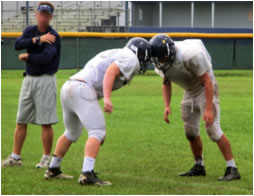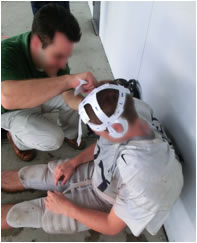Researchers Discover Objective Indicator of Concussion
Lends to opportunity to Protect Professional and Youth Sports Players from Traumatic Brain Injuries

Sport concussion researchers teamed up with football players at a Florida high school. Ten players were equipped with Riddell Revolution Speed helmets, with the embedded Simbex HITS encoders, which were worn throughout the 2011/2 football season. The HITS system recorded the severity and location of all head impacts during both football practice sessions and games.
To measure the physiological effects of acute and cumulative head impacts, players agreed to wear a wireless EEG system, which was housed on the back of the shoulder pads. In addition, heart rate variability, respiration rate as well as linear and angular motion was recorded using a Tricorder developed by ReThink Medical.
During the 2011/2- football season, several concussive level impacts were recorded. Two players were removed from the field due to suspected sport concussion / mTBI, one of whom was wearing the complete data acquisition system, including HITS encoders, Nicolet EEG and ReThink Tricorder at the time of impact and for approximately 30 minutes post-impact. For the first time we have the opportunity to investigate physiological responses and brain activity changes in response to a concussive level head impact.
 Analysis of one player’s self-reported concussive impact clearly shows decreased Gamma band activity and increased Theta band activity in the frontal cortex of the brain immediately following significant head impact. This suggests that the player had reduced cognitive performance and was perhaps in a ‘drowsy’ state for about 10 minutes following impact. During this time, the player may have been dazed and confused and certainly less effective on the field. But more importantly, his ability to protect himself from a second, potentially harmful impact was greatly compromised.
Analysis of one player’s self-reported concussive impact clearly shows decreased Gamma band activity and increased Theta band activity in the frontal cortex of the brain immediately following significant head impact. This suggests that the player had reduced cognitive performance and was perhaps in a ‘drowsy’ state for about 10 minutes following impact. During this time, the player may have been dazed and confused and certainly less effective on the field. But more importantly, his ability to protect himself from a second, potentially harmful impact was greatly compromised.
The findings of our study clearly indicate compromised brain activity as a result of head impact, which appears to be correlated with the magnitude of the impact.
Normalized Power Trend Analysis. Normalized Theta (Left) and Gamma (Right) Power (log of % power within band) of a football player, who experienced a concussion following a moderately forceful head impact (Red line), show phasic modulations in power throughout the practice. Fluctuations in power rarely exceed 25% of the total average power for the recording session in Theta and Gamma frequencies. Yet, immediately following a violent hit (Red line), gamma power begins to decline rapidly and exceeds an arbitrary criterion of ±50% change from average power (peaking at 90 min.). Indeed gamma power remained within 20% of the mean for most of the duration of practice, exceeding this degree of change for over 10 minutes after the impact and two other brief episodes (around 20 min. and 50 min. for less than five minutes; Note, the first and last five minutes were ignored due to the temporal filtering artifact at both edges). Whereas, a peak in theta power coincided with the greatest change in gamma power, the degree of change from the mean normalized power never exceeded 10%. This preliminary data suggests that our algorithms provide (1) the sensitivity to detect significant change in brain activity following a concussive event, and (2) specificity in detecting which frequency band (i.e., gamma) provides the most meaningful brain signal for detecting concussion / brain trauma
Our future goals for the upcoming football season include a new micro-EEG recorder, which is in development, that will allow unobtrusive measurement of several players simultaneously during both football practice and games.
Ultimately, it is our hope that this technology will be widely available to both professional and youth teams so that medical staff can monitor the brain health of players in real-time so that injured participants can be objectively identified, effectively protected and successfully treated.

